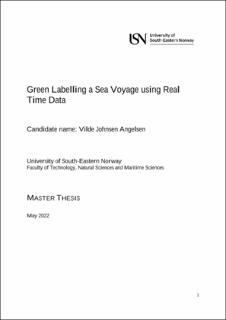| dc.description.abstract | A case study research design of a sea voyage between Port A and Port B was chosen for this study. The goal was to identify challenges and bottlenecks of sea-going activities inside and between ports. The purpose is to contribute to the body of knowledge regarding green labelsin the maritime industry, as well as contributing to identifying parameters for a green framework. Three interviews were conducted: with the port authority of Port B, a VTS System Supplier, and a Norwegian environmental organization. In addition, secondary data sources were studied from Port A. An extensive literature review was carried out, analysed thematically to identify consistency of related research. The findings from the industry and the literature were eventually compared with the aim of identifying similarities and potential knowledge gaps between industry and research.
The findings suggest that challenging areas within maritime shipping can be related to regulatory, collaborative, standardization, and motivational factors. In terms of regulations, barriers, stopping sustainable progression, were identified in charter parties, encouraging shipowners and operators to sail full speed to port, rather than at economical speed, despite long anchorage times in ports. The maritime industry consists of complex stakeholder environments, where stakeholders represent different interests and financial models. Collaboration would increase communication, data sharing, and potentially increase efficiency. In ports, the visiting vessels, terminals, and VTSOs collect different data, which, if shared, could allow the stakeholders to make more efficient decisions. Standardization of parameters to measure environmental performance, methodologies, measuring- and analytical tools is vital to ensure that the market conditions are equal. Data sharing and different data formats are outlined as a cut barrier for adopting green frameworks. The maritime industry is known for its conservativity, suggesting that implementing innovations can be difficult. The motivational factors outlined in this study relates to reluctance of sharing and collaborating, “watch-and-wait” attitude, and business-as-usual approaches.
While many of the industry findings correlated with the literature findings, there were some differences, especially related to motivational factors for adopting green labels. Additionally, findings suggests that when conducting studies in the maritime industry, one should have a holistic view, where different stakeholder opinions are considered, to ensure the complexity of the industry is embraced. | en_US |
